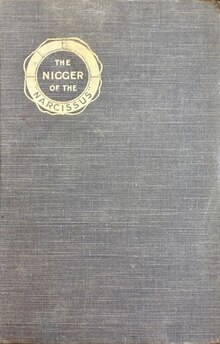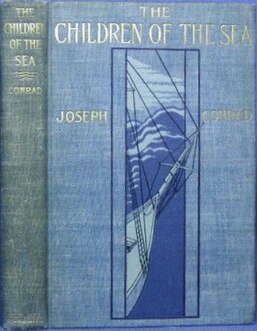This is an old revision of this page, as edited by 2003:e0:bf1f:8f80:b5fd:78c1:2f3b:dbca (talk) at 04:01, 31 March 2022. The present address (URL) is a permanent link to this revision, which may differ significantly from the current revision.
Revision as of 04:01, 31 March 2022 by 2003:e0:bf1f:8f80:b5fd:78c1:2f3b:dbca (talk)(diff) ← Previous revision | Latest revision (diff) | Newer revision → (diff) Novel by Joseph Conrad "The Children of the Sea" redirects here. For other works by this title, see Children of the Sea (disambiguation). First edition cover from the UK First edition cover from the UK | |
| Author | Joseph Conrad |
|---|---|
| Language | English |
| Genre | Nautical fiction |
| Set in | A ship on the Indian Ocean and Atlantic Ocean |
| Publisher | Heinemann |
| Publication date | December 1897 |
| Publication place | United Kingdom |
| Media type | Print: hardback |
| Pages | 120 |
| OCLC | 843064325 |
| Dewey Decimal | 823.912 |
| LC Class | PR6005.O57 |
| Preceded by | An Outcast of the Islands |
| Followed by | Heart of Darkness |
| Text | The Nigger of the "Narcissus" at Wikisource |

The Nigger of the "Narcissus": A Tale of the Forecastle (sometimes subtitled A Tale of the Sea), first published in the United States as The Children of the Sea, is an 1897 novella by Joseph Conrad published in the United Kingdom. The central character is an Afro-Caribbean man who is ill at sea while aboard the trading ship Narcissus heading towards London. Controversy surrounding the use of the word nigger in the title led not only to the altered US title in 1897, but to the 2009 version The N-Word of the Narcissus.
Because of the novella's superb quality compared to Conrad's earlier works, some critics have described it as marking the start of Conrad's major or middle period; others have placed it as the best work of his early period.
Preface
Conrad's preface to the novel, regarded as a manifesto of literary impressionism, is considered one of his most significant pieces of nonfiction writing. It begins with the line: "A work that aspires, however humbly, to the condition of art should carry its justification in every line".
Plot
See also: Glossary of nautical termsThe title character, James Wait, is a dying West Indian black sailor on board the merchant ship Narcissus, on which he finds passage from Bombay to London. Suffering from tuberculosis, Wait becomes seriously ill almost from the outset, eliciting suspicion from much of the crew, though his ostensible plight arouses the humanitarian sympathies of many. The ship's white master, Captain Allistoun, and an old white sailor named Singleton remain concerned primarily with their duties and appear indifferent to Wait's condition. Rounding the Cape of Good Hope, the ship capsizes onto her beam-ends during a sudden gale and half her hull is submerged, with many of the crew's rations and personal belongings lost; the men cling onto the deck for an entire night and day, waiting in silence for the ship to turn over the rest of the way and sink. Allistoun refuses to allow the masts to be severed, which might allow the hull to right itself but would prevent the ship from making use of her sails. Five of the men, realizing that Wait is unaccounted for, climb down to his cabin and rescue him at their own peril. When the storm passes and a wind returns, Allistoun directs the weary men to catch the wind, which succeeds in righting the ship.
The voyage resumes but eventually drifts into the doldrums, where the head winds diminish and the ship is becalmed for many days. Rations grow even scarcer and the men become anxious to return home. Wait eventually confesses to a lazy Cockney sailor named Donkin that he is not as sick as he first claimed: that he is feigning illness to avoid having to participate in the laborious work required of every healthy seaman. Many others had already grown suspicious of him, and Captain Allistoun reveals Wait's charade before the entire crew. Wait claims he feels well enough now to work, but the captain orders that he be confined to the forecastle for the remainder of the voyage, a decision which quickly polarizes much of the crew between Wait's supporters and detractors. Allistoun prevents a near-mutiny encouraged by the conniving Donkin. Forced to stay abed, Wait grows increasingly frail as his condition deteriorates. The ship continues to drift without a breeze and some of the crew, including Singleton, begin to whisper that Wait himself is responsible, and that only his death will bring favorable winds.
As the ship passes the Azores and Wait nears death, Donkin discreetly plunders Wait's personal belongings from his sea chest. Wait eventually succumbs and dies -- the first proof that he was genuinely ill. This occurs within sight of land, as Singleton had predicted, and a strong wind returns immediately after Wait's body is committed to the sea. The Narcissus soon arrives in England.
History
The work, written in 1896 and partly based on Conrad's experiences of a voyage from Bombay to Dunkirk, began as a short story but developed into a novella of some 53,000 words. As it grew, Conrad began to think of its being serialized. After Smith Elder had rejected it for the Cornhill Magazine, William Ernest Henley accepted it for the New Review, and Conrad wrote to his agent, Edward Garnett, "Now I have conquered Henley, I ain't 'fraid o' the divvle himself!" Some years later, in 1904, Conrad described this acceptance as "the first event in my writing life which really counted".
In the United States, the novel was first published under the title The Children of the Sea: A Tale of the Forecastle. The original had proven controversial in England, with one reviewer calling it "the ugliest conceivable title"; American reviewers were mixed, with one praising the new title for "superior refinement" and another arguing it "insulted the public by imputing prudery to the American reader."
In 2009, WordBridge Publishing published a new edition with the censored title The N-Word of the Narcissus, which completely excised the word "nigger" from the text. According to the publisher, the offensive word may have led readers to avoid the book, and thus by getting rid of it the work was made more accessible to modern readers.
Analysis
The novel can be seen as an allegory about isolation and solidarity, with the ship's company serving as a microcosm of a social group. Conrad appears to suggest that humanitarian sympathies are, at their core, feelings of self-interest and that a heightened sensitivity to suffering can be detrimental to the management of a human society.
In 2006, in his critical study of Conrad, John G. Peters said of the work:
The unfortunately titled The Nigger of the "Narcissus" (titled The Children of the Sea in the first American edition) is Conrad's best work of his early period. In fact, were it not for the book's title, it undoubtedly would be read more often than it is currently. At one time, it was one of Conrad's most frequently read books. In part because of its brevity, in part because of its adventure qualities, and in part because of its literary qualities, the novel used to attract a good deal of attention."
See also
Notes
- The forecastle is the forward part of a ship with the sailors' living quarters, or the upper deck of a sailing ship forward of the foremast.
References
- www.bibliopolis.com. "THE CHILDREN OF THE SEA by Joseph Conrad on Sumner & Stillman". Sumner & Stillman. Retrieved 2021-03-09.
- Jenny Stringer, ed., The Oxford Companion to Twentieth-Century Literature in English
- ^ David Daiches, A Critical History of English Literature, vol. 2 (1969, revised edition by Mandarin, 1994, ISBN 0-7493-1894-5)
- Ian Ousby, The Wordsworth Companion to Literature in English (Wordsworth, 1992, revised paperback edition 1994, ISBN 1-85326-336-2)
- Orr, Leonard (1999), A Joseph Conrad Companion, Greenwood Press, ISBN 0-313-29289-2
- Preface, The Nigger of the "Narcissus" and Other Stories (Digireads, 2010), p. 120
- Peter D. McDonald, British Literary Culture and Publishing Practice, 1880-1914 (2002), p. 28
- GOONETILLEKE, D.C.R.A. (2011). "Racism and "The Nigger of the "Narcissus""". Conradiana. 43 (2/3): 51–66. ISSN 0010-6356.
- RUDE, DONALD W.; DAVIS, KENNETH W. (1992). "THE CRITICAL RECEPTION OF THE FIRST AMERICAN EDITION OF "THE NIGGER OF THE 'NARCISSUS'"". The Conradian. 16 (2): 46–56. ISSN 0951-2314.
- "The N-Word of the Narcissus by Joseph Conrad". www.powells.com. Retrieved 2021-03-05.
- Conrad, Joseph; Alvarado, Ruben (7 December 2009). The N-Word of the Narcissus. WordBridge Publishing. ISBN 978-9076660110.
- ^ Norris W. Yates 'Social Comment in The Nigger of the "Narcissus"' in Proceedings of the Modern Language Association of America, vol. 79, issue 1 (Modern Language Association, 1964), pp. 183–185, doi:10.2307/460979, JSTOR 460979
- John G. Peters, The Cambridge Introduction to Joseph Conrad (Cambridge University Press, 2006, ISBN 978-0-521-54867-0)
Further reading
- Jacques Berthoud (1978), Joseph Conrad: The Major Phase, Cambridge University Press, ISBN 0-521-29273-5
- Peter Villiers (2006), Joseph Conrad: Master Mariner, Seafarer Books, ISBN 0954706293
External links
- The Nigger of the "Narcissus" at Project Gutenberg (plain text and HTML)
- The Nigger of the "Narcissus" at Internet Archive and Google Books (scanned books original editions color illustrated)
 The Nigger of the Narcissus public domain audiobook at LibriVox
The Nigger of the Narcissus public domain audiobook at LibriVox
| Joseph Conrad (works) | |
|---|---|
| Novels and novellas |
|
| Short stories | |
| Other works |
|
| Adaptations |
|
| Related | |